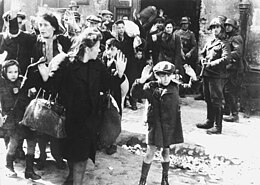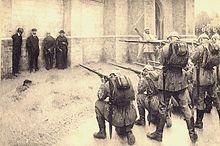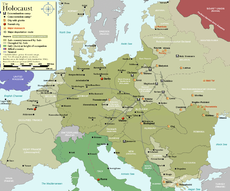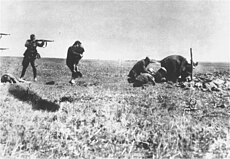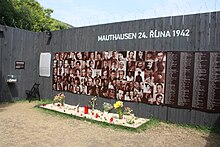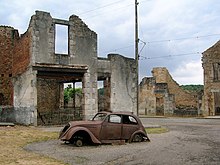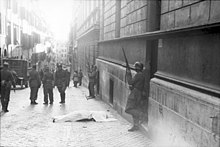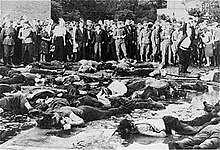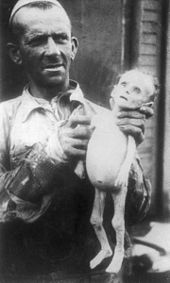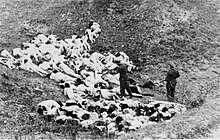
Majdanek was a Nazi concentration and extermination camp built and operated by the SS on the outskirts of the city of Lublin during the German occupation of Poland in World War II. It had seven gas chambers, two wooden gallows, and some 227 structures in all, placing it among the largest of Nazi concentration camps. Although initially intended for forced labor rather than extermination, it was used to murder people on an industrial scale during Operation Reinhard, the German plan to murder all Polish Jews within their own occupied homeland. In operation from 1 October 1941 to 22 July 1944, it was captured nearly intact. The rapid advance of the Soviet Red Army during Operation Bagration prevented the SS from destroying most of its infrastructure, and Deputy Camp Commandant Anton Thernes failed to remove the most incriminating evidence of war crimes.
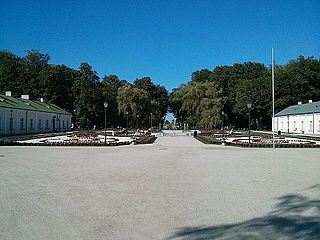
Końskie is a town in south-central Poland with 20,328 inhabitants (2008), situated in the Świętokrzyskie Voivodeship. Historically, Końskie belongs to the province of Lesser Poland, and since its foundation, until 1795, it was part of Lesser Poland's Sandomierz Voivodeship.

Around six million Polish citizens are estimated to have perished during World War II. Most were civilians killed by the actions of Nazi Germany, the Soviet Union, the Lithuanian Security Police, as well as the Organization of Ukrainian Nationalists and its offshoots.

The massacres of Poles in Volhynia and Eastern Galicia were carried out in German-occupied Poland by the Ukrainian Insurgent Army (UPA) with the support of parts of the local Ukrainian population against the Polish minority in Volhynia, Eastern Galicia, parts of Polesia and the Lublin region from 1943 to 1945. The ruling Germans also actively encouraged both Ukrainians and Poles to kill each other.

The 1940 AB-Aktion, a second stage of the Nazi German campaign of violence in Poland during World War II, aimed to eliminate the intellectuals and the upper classes of the Second Polish Republic across the territories slated for eventual annexation by the German Reich.
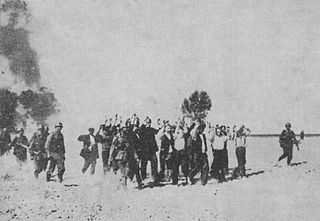
Pacification actions were one of many punitive measures designed by Nazi Germany to inflict terror on the civilian population of occupied Polish villages and towns with the use of military and police force. They were an integral part of the war of aggression against the Polish nation waged by Germany since September 1, 1939. The projected goal of pacification operations was to prevent and suppress the Polish resistance movement in World War II nevertheless, among the victims were children as young as 1.5 years old, women, fathers attempting to save their families, farmers rushing to rescue livestock from burning buildings, patients, victims already wounded, and hostages of many ethnicities including Poles and Jews.

During World War II, the German Wehrmacht committed systematic war crimes, including massacres, mass rape, looting, the exploitation of forced labour, the murder of three million Soviet prisoners of war, and participated in the extermination of Jews. While the Nazi Party's own SS forces was the organization most responsible for the genocidal killing of the Holocaust, the regular armed forces of the Wehrmacht committed many war crimes of their own, particularly on the Eastern Front.
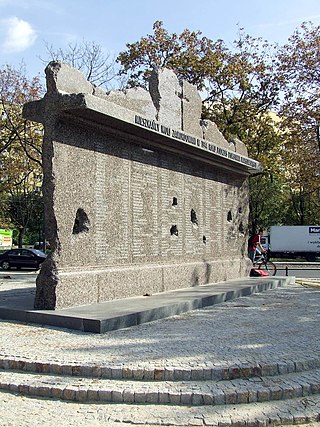
Crimes against the Polish nation committed by Nazi Germany and Axis collaborationist forces during the invasion of Poland, along with auxiliary battalions during the subsequent occupation of Poland in World War II, included the genocide of millions of Polish people, especially the systematic extermination of Jewish Poles. These mass killings were enacted by the Nazis with further plans that were justified by their racial theories, which regarded Poles and other Slavs, and especially Jews, as racially inferior Untermenschen.
Holocaust victims were people targeted by the government of Nazi Germany based on their ethnicity, religion, political beliefs, or sexual orientation. The institutionalized practice by the Nazis of singling out and persecuting people resulted in the Holocaust, which began with legalized social discrimination against specific groups, involuntary hospitalization, euthanasia, and forced sterilization of persons considered physically or mentally unfit for society. The vast majority of the Nazi regime's victims were Jews, Sinti-Roma peoples, and Slavs but victims also encompassed people identified as social outsiders in the Nazi worldview, such as homosexuals, and political enemies. Nazi persecution escalated during World War II and included: non-judicial incarceration, confiscation of property, forced labor, sexual slavery, death through overwork, human experimentation, undernourishment, and execution through a variety of methods. For specified groups like the Jews, genocide was the Nazis' primary goal.
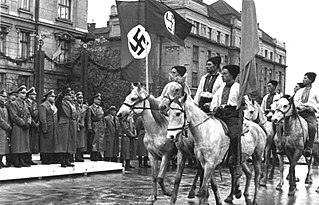
Ukrainian collaboration with Nazi Germany took place during the occupation of Poland and the Ukrainian SSR, USSR, by Nazi Germany during the Second World War.

The Ponary massacre, or the Paneriai massacre, was the mass murder of up to 100,000 people, mostly Jews, Poles, and Russians, by German SD and SS and the Lithuanian Ypatingasis būrys killing squads, during World War II and the Holocaust in the Generalbezirk Litauen of Reichskommissariat Ostland. The murders took place between July 1941 and August 1944 near the railway station at Ponary, a suburb of today's Vilnius, Lithuania. 70,000 Jews were murdered at Ponary, along with up to 2,000 Poles, and 8,000 Soviet POWs, most of them from nearby Vilnius, and its newly formed Vilna Ghetto.

The Holocaust in Ukraine was the systematic mass murder of Jews in the Reichskommissariat Ukraine, the General Government, the Crimean General Government and some areas which were located to the East of Reichskommissariat Ukraine, in the Transnistria Governorate and Bessarabia, Northern Bukovina and the Hertsa region and Carpathian Ruthenia during World War II. The listed areas are currently parts of Ukraine.
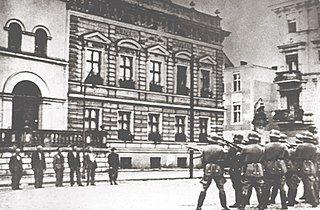
The Intelligenzaktion, or the Intelligentsia mass shootings, was a series of mass murders which was committed against the Polish intelligentsia early in the Second World War (1939–45) by Nazi Germany. The Germans conducted the operations in accordance with their plan to Germanize the western regions of occupied Poland, before their territorial annexation to the German Reich.
The massacres in Piaśnica were a series of mass murders carried out by Nazi Germany during World War II, between the fall of 1939 and spring of 1940 in Piaśnica Wielka in the Darzlubska Wilderness near Wejherowo. The exact number of people murdered is unknown, but estimates range between 12,000 and 14,000 victims. Most of them were Polish intellectuals from Gdańsk Pomerania, but Poles, Kashubians, Jews, Czechs and German inmates from mental hospitals from the General Government and the Third Reich were also murdered. After the Stutthof concentration camp, Piaśnica was the largest site of killings of Polish civilians in Pomerania by the Germans, and for this reason, is sometimes referred to as the "second" or "Pomeranian" Katyn. It was the first large-scale Nazi atrocity in occupied Poland.
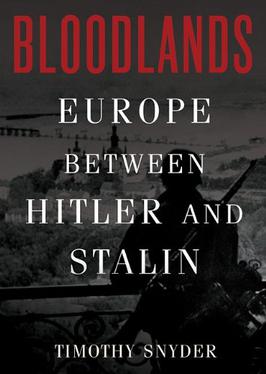
Bloodlands: Europe Between Hitler and Stalin is a 2010 book by Yale historian Timothy Snyder. It is about mass murders committed before and during World War II in territories controlled by Nazi Germany and the Soviet Union.

Around 6 million Polish citizens perished during World War II: about one fifth of the pre-war population. Most were civilian victims of the war crimes and crimes against humanity during the occupation by Nazi Germany and the Soviet Union. Approximately half were Polish Jews killed in The Holocaust. Statistics for Polish World War II casualties are divergent and contradictory. This article provides a summarization of these estimates of Poland's human losses in the war and their causes.

The occupation of Poland by Nazi Germany and the Soviet Union during World War II (1939–1945) began with the Invasion of Poland in September 1939, and it was formally concluded with the defeat of Germany by the Allies in May 1945. Throughout the entire course of the occupation, the territory of Poland was divided between Nazi Germany and the Soviet Union (USSR), both of which intended to eradicate Poland's culture and subjugate its people. In the summer-autumn of 1941, the lands which were annexed by the Soviets were overrun by Germany in the course of the initially successful German attack on the USSR. After a few years of fighting, the Red Army drove the German forces out of the USSR and crossed into Poland from the rest of Central and Eastern Europe.
This is a list of war crimes committed during World War II.

During the German invasion of Poland, which started World War II, Nazi Germany carried out a number of atrocities involving Polish prisoners of war (POWs). During that period, the Wehrmacht is estimated to have mass murdered at least 3,000 Polish POWs, with the largest atrocities being the Ciepielów massacre of 8 September 1939 and the Zambrów massacre of 13–14 September. Most of those atrocities are classified as war crimes of the Wehrmacht. Jewish soldiers with the Polish Army were also more likely than others to be victims of various atrocities.
